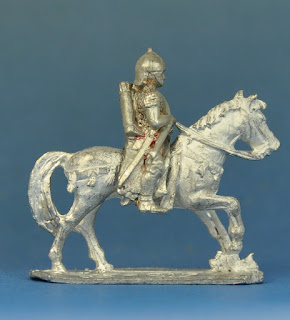This figure is the Heavy Cavalryman - late 3rd Century AD that first appeared in the Miniature Figurines 72/73 catalogue as PBC 130. I have added Roman to the title as Minifigs assumed we knew.
Both PB ranges were based on Phil Barker's books Armies of the Macedonian and Punic Wars and The Armies and Enemies of Imperial Rome. This figure is taken from illustration 30 in the first edition of AEIR.
The code numbers for the AEIR range correspond to the illustrations in the book plus '100', i.e. illustration 1 is figure 101.
Cavalry models carried the code number on a tag - long since removed - which can make identification a little harder in some cases. I'm fairly confident of this one with its distinctive shield shape and cloak.
I have mounted this rider onto a PBH 65-217, which is not quite the right horse but close enough. As so often with this range we have the double saddle cloth - rider and horse each having their own
It's not clear where the source for this model comes from and, to be honest, there isn't much to distinguish this cavalryman from 1st and 2nd century versions bar the rather larger shield. I'd be happy to absorb him into the ranks of an Early Imperial Army (EIR) army, and that may indeed be his fate.
The Armies and Enemies of Imperial Rome book, from which his figure derives, has a number of 3rd Century cavalry illustrations and Minifigs dutifully made a model for each. Despite that, they don't turn up often, and some I have yet to get my hands on. At the time I suspect gamers went for EIR armies or 'Late Roman' armies of the 4th and 5th centuries, and those in between went by the wayside as neither fish, fowl nor good red meat.






























